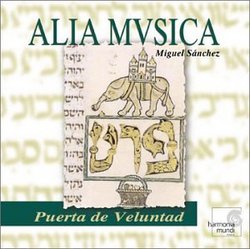| All Artists: Alia Musica Title: Puerta de Veluntad Members Wishing: 0 Total Copies: 0 Label: Harmonia Mundi Fr. Release Date: 5/8/2001 Album Type: Import Genre: Classical Styles: Opera & Classical Vocal, Chamber Music, Historical Periods, Early Music Number of Discs: 1 SwapaCD Credits: 1 UPCs: 8427592000263, 713746223427 |
Search - Alia Musica :: Puerta de Veluntad
 | Alia Musica Puerta de Veluntad Genre: Classical
|
Larger Image |
CD Details |
CD ReviewsThe genetic salad bowl of western and oriental music Jacques COULARDEAU | OLLIERGUES France | 03/12/2009 (5 out of 5 stars) "The first set of songs are dedicated to the Jewish New Year, and is not conveying joy but repentance for all the evil acts done and performed in the previous year. That is some kind of collective confession or balance sheet of the accounts of the Jewish people with God. If you are careful in your listening you will feel as much as hear and even see the link with traditional Gregorian chant the way it is coming out in this tenth century. The opening of the first piece is just that, but very fast, as soon as the second piece, you shift to the very specific Jewish tradition of Spain, that tradition that pushes its roots into the culture of that peninsula in those days, under the ruling power of Islam. The instruments are Oriental, the singing is typical of that Orient and the music is so Arabic that when we do not understand the language, which is a Semitic language anyway, we could think we are in an Islamic tradition. But in fact this very Oriental and Arabic music turns into a Jewish tradition: the music is not so much in a pure Islamic tone and the singing changes too. We recognize then a style that has survived up to today in various cultural forms of Jewish music in the world. And yet the third piece reintroduces the type of music I have said is at the root of, Gregorian music. Hence three styles mix and merge to build this musical vision, because it is a vision of life and the world, of God too. The vision is a repentance as we said, even if in the second part of the CD we move to Yom Kippur, the great atonement. It is always this vision of the Jewish people, the people chosen by God to be his representative on earth, confronted to their mission and finding themselves far from being able to perform it. That repenting tone is ever present. The chorus in the fifth piece for instance goes slightly beyond this repenting tone and creates some kind of unified collective voice that has some level of serenity. The sixth piece has another tone I have often found in the sacred music people in mountainous Corsica or Sardinia developed a long time ago and have kept through the centuries. This means that this music has retained a deeply popular inspiration coming from the various places where the people have developed their society and life. The first use of a female voice in the eighth piece, singing unaccompanied with some short instrumental interludes does not change that general tone, and in a way maybe makes that repenting tone even direr. We reach with her a nearly complete absence of any positive vision of man's life, the absolute and unique certitude of the dissatisfaction of God with our mis-implementation of our divine mission. And the ninth piece becomes a dirge, nearly a funeral song, the chorus amplifying the chant into the acceptation of that lot of suffering and repentance, or is it the nostalgia of our union with God before we were separated from him and thrown out of the Garden of Eden. A slightly more positive tone is introduced in the tenth piece, dedicated to Israel, the people of God. But the music and the chant remains very repetitive and in a way closed on a belief and a faith, but no open future or perspective. And it loses all poetic or harmonic approach in the thirteenth piece where the musical psalmodic form is replace by the very flat prosodic form that is some kind of reciting of some sacred text on a monotonous humdrum chanting tone that does not aim at reaching anyè elaboration at all, as if to speak to God we had to show our submission in such a flattened prose. After a moment of great surprising sonorous creativity in the fifteenth piece, we go back to the tone of the very beginning, a tone which is very close to the Gregorian tradition the Christian world is inventing at that very same time, in this very tenth century in the sixteenth piece and the Oriental tone of the beginning too in the seventeenth piece bringing thus the two main trends of this music to conclude the whole CD, though, as we have seen there are more roots and more branches to that musical tree. Was that Jewish music in Spain at the time the melting pot of many traditions or already a salad bowl of the coming together of these various traditions?
Dr Jacques COULARDEAU, University Paris 1 Pantheon Sorbonne, University Versailles Saint Quentin en Yvelines, CEGID" |

 Track Listings (17) - Disc #1
Track Listings (17) - Disc #1